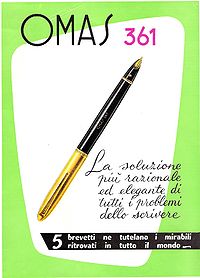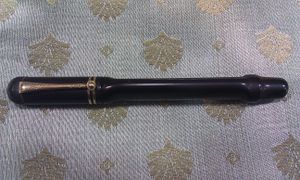Differenze tra le versioni di "Omas/en"
| Riga 26: | Riga 26: | ||
The turning point in the [[OMAS]] production was in 1932, when the pen that remained for decades one of the brand flagship models, the [[Omas Extra|Extra]], was introduced. It was a [[lever filler]] made using a multifaceted celluloid, decorated with a wide band on the cap, engraved with a greek shaped pattern. The pen was produced in four different sizes and launched with the slogan ''creazione di artista e di scienziato''<ref>meaning ''creation by artist and scientist''.</ref> that was accompanied by an extensive advertising campaign. | The turning point in the [[OMAS]] production was in 1932, when the pen that remained for decades one of the brand flagship models, the [[Omas Extra|Extra]], was introduced. It was a [[lever filler]] made using a multifaceted celluloid, decorated with a wide band on the cap, engraved with a greek shaped pattern. The pen was produced in four different sizes and launched with the slogan ''creazione di artista e di scienziato''<ref>meaning ''creation by artist and scientist''.</ref> that was accompanied by an extensive advertising campaign. | ||
| − | + | Although [[Omas Extra|Extra]] was very similar to the [[Eversharp]] [[Doric]], introduced a few months before, it is still controversial whether it is an imitation, since the time between the two pens is rather short. [[OMAS]] estimators point out that given the short time between the release of two pens, it would not possible to create production facilities if the [[Omas Extra|Extra]] was a [[Doric]] imitation. but there is no information supporting this claim, and many evidence of the company abit to imitate american models. Whether the [[Omas Extra|Extra]] can be considered an imitation or not, for its materials, quality and workmanship, it is at the same level, if not better, than the models which it may have been inspired. The pen was an huge success and remained in production until 1946, albeit with minor stylistic changes, like the introduction of a smooth version and the substitution of the wide band with three tiny rings. | |
[[Image:Lucens-VestPocket-Extended.jpg|left|thumb|Una coppia di [[Lucens]] ]] | [[Image:Lucens-VestPocket-Extended.jpg|left|thumb|Una coppia di [[Lucens]] ]] | ||
Versione delle 18:04, 15 feb 2012
OMAS was founded in 1925 and is an historical Italian fountain pen brand. Since then, although with varying fortunes and many changes in ownership occurred after the death of its founder, the brand has always remained active in the market. Property passed in 2000 to the French luxury brand Louis Vuitton, who sold the company to Chinese brand Xinyu Hengdeli in October 2007.
During its history OMAS made some considerable technical innovations and always had a very high production quality, making pens that were probably the best in the Italian production. And also if their more famous model are almost always showing a clear imitation of the stylistic characteristics of foreign models, they were often more beautiful and better quality than the originals. The absolute quality of the OMAS production, and the refinement of the celluloid used by this brand, makes OMAS pens among the most sought after by collectors.
History

OMAS was founded in Bologna in 1925 by Armando Simoni. In 1919, Simoni, just married, opened a workshop in Via S. Vitale producing film reels and safeties mechanisms.[1] Shortly Simoni began to produce spare parts for the most important fountain pen brands. They had a considerable success and customer demands grew making the activity expand, so a whole pens productions began. This early years models, not marked OMAS were hard rubber pens with safety or lever filler, made as a clear imitation of Waterman models.
But it was only in 1925, when the construction of the factory in Via degli Orbi was completed that Officine Meccaniche Armando Simoni was born, and the acronym OMAS become the brand under which fountain pens were marketed. The first OMAS major model was the Penna del dottore, patented in 1927. It was a lever filler hard rubber model having a compartment inside the barrel that contained, in addition to the filling mechanism, a thermometer to measure temperature, kept separate from the rest by a metal partition. In the same year OMAS got another patent for the metal joint used for the realization of desk pens, for which the company was one of the main Italian producers.
The OMAS initial production is characterized by some button filler Flat top models, that were a clear imitations of the Duofold. But some of these sported original technical solutions, like the second version of the Penna del dottore in which the thermometer was again hosted by the body of the pen, or the penna del calligrafo, directed to the use by calligraphers, which was equipped with a special section that can be unscrewed and replaced, allowing an easy nib change.
In this early period there is trace of some Parker models (Duofold and Thrift Time) marked Geo. S. Parker - fabbricato in Italia whose production is attributed to OMAS. There is a debate about these pens, whether they are a real production on Parker commission, made to circumvent the restrictions by the autarkic policies of the fascist regime, or it is a semi-official production ordered by the Parker agent for Italy, Edoardo Webber, which was facing a supply shortage, or whether it really was a clandestine (and illegal) production. As there are no documents, and no other findings than proof of a subsequent relationships between Simoni and Webber for the production of Saratoga fountain pen, there is any definitive conclusion.
OMAS was between first Italian companies to move production to celluloid between the late '20s and early '30s. The company produced its fountain pen in classic colors as jade green or lapis blue as well as other interesting variations of marbled colors. Among this early celluloid production some pens stand out, similar to the previous Duofold imitations, but with tapered ends, probably born in the early 30s years with the establishment of the streamlined style; only a few examples of this production are known. The start of production for Minerva branded pens can be traced back more or less to this period. This was the only official Omas sub-brand,[2] dedicated to second tier pens production, that nevertheless were of excellent quality.
The turning point in the OMAS production was in 1932, when the pen that remained for decades one of the brand flagship models, the Extra, was introduced. It was a lever filler made using a multifaceted celluloid, decorated with a wide band on the cap, engraved with a greek shaped pattern. The pen was produced in four different sizes and launched with the slogan creazione di artista e di scienziato[3] that was accompanied by an extensive advertising campaign.
Although Extra was very similar to the Eversharp Doric, introduced a few months before, it is still controversial whether it is an imitation, since the time between the two pens is rather short. OMAS estimators point out that given the short time between the release of two pens, it would not possible to create production facilities if the Extra was a Doric imitation. but there is no information supporting this claim, and many evidence of the company abit to imitate american models. Whether the Extra can be considered an imitation or not, for its materials, quality and workmanship, it is at the same level, if not better, than the models which it may have been inspired. The pen was an huge success and remained in production until 1946, albeit with minor stylistic changes, like the introduction of a smooth version and the substitution of the wide band with three tiny rings.
Nel 1936 venne brevettato ed introdotto un nuovo modello, la Lucens dotato di un originale, per l'Italia, sistema di caricamento, denominato stantuffo tuffante. In realtà il meccanismo è sostanzialmente identico a quello usato dalla Dunn, precedente di ben 15 anni, anche se non è possibile stabilire se si tratti di una copia o di una realizzazione indipendente. La Lucens costituisce comunque una delle più belle penne stilografiche mai realizzate, in particolare per la bellezza della celluloide utilizzata, dotata di sezioni trasparenti per la visualizzazione dell'inchiostro.
Realizzata inizialmente in versione liscia, alla Lucens si unì subito anche la Extra Lucens, dotata di un corpo sfaccettato come la Extra, ma con caricamento a stantuffo tuffante. Nel 1938 la precedente clip a rotellina (molto simile a quella della Doric della Eversharp) venne sostituita da una clip a forma di freccia, chiara imitazione di quella introdotta dalla Parker con la Vacumatic, imitazione ancor più evidente dalla presenza di un disegno di freccia sostanzialmente identico inciso sul pennino. Inoltre la decorazione a vera grecata venne sostituita da tre sottili vere sul cappuccio. Nonostante le imitazioni la Extra Lucens resta una penna senza ombra di dubbio superiore in tutti gli aspetti (tecnico, estetico e di qualità realizzativa) a qualunque Vacumatic e probabilmente il più bel modello prodotto dalla OMAS.
Col progredire della guerra iniziarono a scarseggiare le materie prime ed in particolare l'oro per i pennini, come la gran parte delle aziende europee la OMAS dovette ricorrere ad una lega di acciaio, ribattezzata Permanio, della quale si proclamava la superiorità anche rispetto all'oro. In realtà proprio questa lega risultò essere una delle più suscettibili alla corrosione, tanto che oggi i pennini in Permanio sono rarissimi ed hanno un valore ben più alto dei loro analoghi in oro.
Nel dopoguerra la produzione riprese con nuove penne di forma ogivale, ed il passaggio al caricamento a stantuffo. Nel 1946 la linea Extra venne completamente ristilizzata, venne mantenuta la clip a rotellina ma vennero usate tre verette sul cappuccio, inoltre venne adottato il caricamento a stantuffo e venne introdotta una sezione trasparente per la visualizzazione del livello di inchiostro. Vennero mantenute tre misure, piccola, media e grande, identificate rispettivamente coi numeri 555, 556 e 557.

Nel 1948 venne realizzata quella che è forse la più significativa invenzione nel mondo della stilografica italiana, il modello 361. Nata in risposta al successo della Parker 51, l'originalità della penna sta nella posizione centrale del pennino, montato sull'asse della penna, intorno al quale ruota un controcappuccio aperto su un lato. A seconda della posizione di quest'ultimo, ed in particolare del lato aperto, il pennino può venire quasi completamente coperto, ottenendo una scrittura rigida, o lasciato scoperto, consentendo una scrittura flessibile. Un sistema di gradazione del tratto molto funzionale, tanto che si narra che la stessa Parker tentò più volte di acquisire il brevetto (nº US-2565667 ) dalla OMAS.
L'introduzione della 361 portò ad una serie di novità anche sul piano stilistico oltre che su quello tecnico, per la sua produzione vennero infatti adottate delle nuove linee di forma ogivale, inoltre si passò ad una singola veretta sul cappuccio ed al meccanismo di caricamento a stantuffo che venne utilizzato per tutta la produzione eccettuata la Extra Lucens che rimase con lo stantuffo tuffante, la clip a freccia ed i tre anellini sul cappuccio, restando in produzione, sia pure senza pennino bicolore, nel solo colore nero e nelle dimensioni grande e media per tutti gli anni '50.
Sono inoltre da segnalare, introdotti all'incirca nel 1950 e mantenuti in produzione per brevissimo tempo, i modelli 351 e 352, penne rarissime ed introvabili, di forma faccettata, ma con caricamento a stantuffo, il cui corpo era realizzato incollando alternativamente sezioni di celluloide trasparente e colorata, così da ottenere uno straordinario risultato di serbatoio trasparente a sezioni alternate.
Nello stesso periodo le forme ogivali della 361 vennero adottate anche per gli altri modelli: venne realizzata la Lucens Ogiva e nuove versioni ogivali della vecchia Extra (denominate 555/S, 556/S e 557/S) costruite in celluloide con finestra trasparente rossa o gialla, e presenti anche nelle varianti con cappuccio metallico. Le forme sfaccettate vennero comunque mantenute, sia per la 361 che per la nuova serie delle Extra con i modelli denominati 555/F, 556/F e 557/F.
Negli anni successivi la produzione della OMAS proseguì, con la realizzazione di penne stilografiche in celluloide con caricamento a stantuffo. L'azienda produsse nuovi modelli coma la VS e la CS. Con la morte di Armando Simoni nel 1958 però non vennero prodotte significative innovazioni, anche se negli ultimi decenni sono stati introdotti diversi modelli, cercando di inseguire la fascia alta del mercato e degli oggetti di lusso, riportando anche in produzione alcuni modelli in celluloide simili a quelli degli anni '30. L'azienda è ancora oggi presente sul mercato, pur essendo passata di mano dagli eredi di Simoni per essere prima ceduta prima alla Luis Vuitton e poi alla cinese Xinyu Hengdeli.
Template:CronoMarche |- | 1925 || Nascita della OMAS |- | 1927 || Viene brevettata la Penna del dottore |- | 1932 || Introdotto il modello Extra |- | 1934 || Introdotto il modello Minerva Classica |- | 1936 || Introdotti i modelli Lucens ed Extra Lucens con caricamento a stantuffo tuffante |- | 1936 || Sostituita la vera con tre anelli sul cappuccio sulla Extra tonda |- | 1938 || Introdotta la clip a freccia sul modello Extra Lucens |- | 1940 || Introdotti i pennini in Permanio |- | 1940 || Sostituita la vera con tre anelli sul cappuccio sulla Extra faccettata |- | 1946 || Ristilizzato il modello Extra, sostituito dalla nuova versione a stantuffo |- | 1948 || Introdotto il modello 361, ristilizzati i modelli Extra |- | 1950 || Introdotti i modelli 351 e 352 |- |}
Template:LegendaModelli |- | Extra || 1932 || XX, ? |- | Lucens || 1936 || XX, ? |- | 361 || 1948 || XX, ? |- |}
Note
- ↑ there is a registration for the Officine Meccaniche di Precisione Simoni Armando in 1922.
- ↑ these are the only pens marketed directly by OMAS, although there are many other productions, often directly derived from Minerva models, known to be made by Omas on behalf of other companies, as the production for Ercolessi, the Saratoga or the Scotland and perhaps also the Nettuno Superba, and double pen models like the Itala and the Zerollo.
- ↑ meaning creation by artist and scientist.
Riferimenti esterni
- http://www.omas.net/ Sito ufficiale dell'azienda, irrilevante per le informazioni storiche
- http://www.rickconner.net/penoply/misc.19.html Articolo con qualche informazione storica
- http://www.rickconner.net/penspotters/omas.html Articolo con qualche informazione storica
- http://www.pennamagazine.com/load_detail.aspx?id=5&nt=stilo Interessante articolo sui modelli tipo Duofold
- http://www.pennamagazine.com/load_detail.aspx?id=4&nt=stilo Altro articolo sui modelli tipo Duofold

